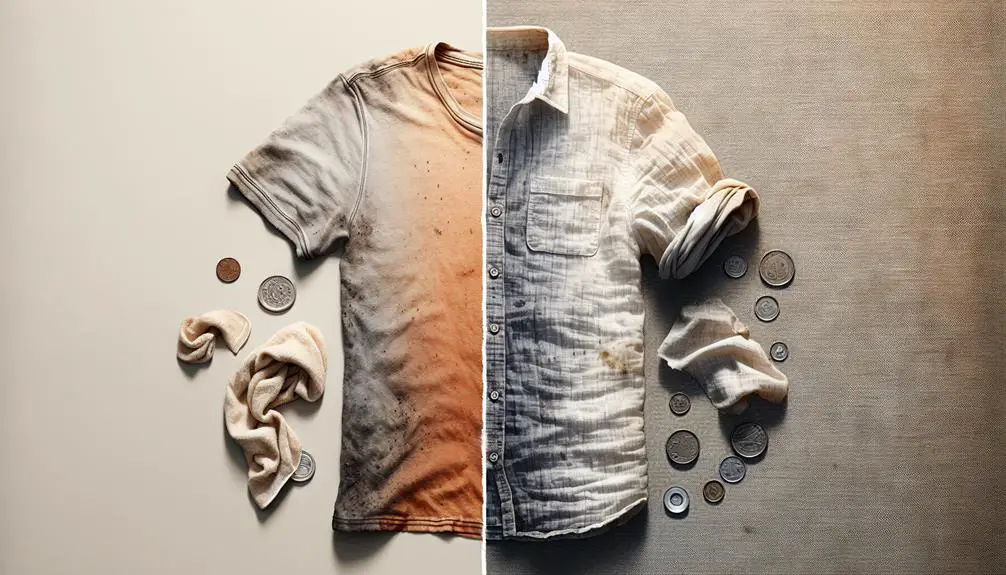Linen lasts longer than cotton due to its strong fibers and resistance to wear and tear. Think of linen like a sturdy car that retains its quality over time, making it a smart investment in the long run. Interested in learning more about why linen is more durable than cotton, and how to maximize the lifespan of both fabrics?
Table of Contents
Key Takeaways
- Linen's sturdy fibers outlast cotton due to exceptional strength.
- Proper care like cold water washing and gentle detergents prolong linen's lifespan.
- Linen's pilling resistance, fraying resistance, and softening with age contribute to its longevity.
- Environmental considerations make linen a sustainable and durable choice over cotton.
- Fabric quality, weaving techniques, and fiber structure significantly impact linen's durability.
Cotton Vs Linen Durability
When comparing cotton and linen durability, linen sheets outlast cotton due to their stronger fibers. Linen's sturdy fibers provide exceptional strength, making it more resistant to wear and tear compared to cotton sheets.
This durability factor guarantees that linen sheets maintain their quality and integrity over a more extended period, even with frequent use and washing. While linen sheets may have a higher upfront cost than cotton, their long-lasting nature proves to be cost-effective in the long run. This makes linen a popular choice for individuals looking for bedding that can withstand the test of time.
The inherent strength of linen fibers not only contributes to the longevity of the sheets but also ensures that they remain in excellent condition despite regular laundering. Ultimately, the durability of linen sheets makes them a practical and reliable option for those seeking bedding that's both resilient and enduring.
Factors Affecting Cotton Longevity
Factors such as thread count, weave type, and fabric quality play a significant role in determining the longevity of cotton sheets. When it comes to cotton sheets, understanding these factors can help you make informed decisions to prolong their lifespan. Here is a breakdown of how each factor affects cotton longevity:
| Factor | Impact | Example |
|---|---|---|
| Thread count | Higher thread count often means more durable sheets | Sheets with 400-600 thread count are usually more long-lasting |
| Weave type | Tighter weaves like sateen are more prone to pilling | Sateen sheets may require more care to prevent pilling |
| Fabric quality | High-quality cotton with long-staple fibers tends to be more durable | Egyptian cotton sheets are known for their longevity |
To guarantee your cotton sheets last longer, consider factors like thread count, weave type, and fabric quality, and practice gentle washing, avoid high heat drying, and use mild detergents.
Factors Affecting Linen Longevity
Linen's durability hinges on the quality of its fibers, making it important to choose high-quality linen products for longevity.
Proper care is also essential; washing linen in cold water and using gentle detergents can greatly prolong its lifespan.
Considering the environmental impact of linen production helps make sustainable choices that benefit both the planet and the longevity of linen products.
Fabric Quality Matters
Understanding the impact of fabric quality on linen longevity is essential for making informed purchasing decisions. When it comes to linen's durability, factors like weaving techniques and fiber structure play a vital role. Here's why fabric quality matters for the longevity of linen:
- Pilling Resistance: Linen's natural resistance to pilling guarantees that it maintains a smooth appearance over time, unlike cotton which may develop pills with wear.
- Fraying Resistance: Due to its strong fibers and tight weave, linen is less prone to fraying compared to cotton, making it a more durable choice for long-term use.
- Softens with Age: Linen softens with each wash while preserving its strength, ensuring that it remains a long-lasting and comfortable fabric option.
Proper Care Essential
Taking good care of your linen fabric is vital for maximizing its longevity and maintaining its quality over time. Linen lasts longer than cotton due to its durable fibers and natural strength. To extend its lifespan, consider washing linen in cold water with mild detergent and avoiding harsh chemicals. Opt for line drying or using a low heat setting in the dryer to prevent weakening of the fibers.
Proper storage is essential too; store linen in a dry, well-ventilated area to prevent deterioration. For long-term storage, use white cotton or muslin to protect linen sheets from dust and discoloration. By following these care tips, you can make sure that your linen pieces remain in excellent condition for years to come.
Environmental Impact Considerations
To understand the environmental impact considerations affecting linen longevity, we must examine the sustainability of its production and the advantages it offers over cotton.
- Sustainability: Linen's production from flax plants requires minimal water and pesticides, making it an eco-friendly choice.
- Durability: Linen's strong and durable fibers contribute to its longevity, outlasting cotton in the long run.
- Biodegradability and Bacteria Resistance: Linen's natural resistance to bacteria and moisture not only prolongs its lifespan but also makes it a sustainable choice due to its biodegradability.
Comparing Cotton and Linen Lifespan
In comparing the lifespan of cotton and linen, linen stands out as the more durable choice, lasting about 30% longer than cotton sheets. Linen's strong fibers and natural properties make it a sustainable and environmentally friendly option, ensuring it maintains its quality over time. Cotton, with its softer fibers, tends to wear out faster than linen, resulting in a shorter lifespan. Linen's durability allows it to withstand numerous washings, making it a cost-effective investment in the long run.
When it comes to longevity, linen surpasses cotton in maintaining its structure, softness, and overall quality for an extended period. Choosing linen over cotton for bedding or clothing can lead to a more sustainable and durable option that not only lasts longer but also retains its high-quality feel despite repeated use and washings.
Tips for Extending Cotton Lifespan
Moving from the comparison of cotton and linen lifespan, we can now focus on practical tips to prolong the longevity of cotton sheets.
Tips for Extending Cotton Lifespan:
- Wash cotton sheets carefully: Use cold water to guarantee no shrinkage and maintain the fabric's integrity.
- Avoid harsh chemicals: Steer clear of bleach and other harsh chemicals that can harm the fibers of your cotton sheets.
- Proper drying and storage: Dry your cotton sheets on a low heat setting to guarantee no damage while maintaining their softness. Additionally, rotate and flip your sheets regularly to ensure even wear and tear. Store them in a cool, dry place away from direct sunlight to prevent discoloration and deterioration.
Tips for Extending Linen Lifespan
Enhancing the lifespan of linen sheets involves washing them in cold water with mild detergent to prevent wear and tear. It's important to dry linen sheets on low heat or line dry to maintain the fabric's integrity.
Avoid using fabric softeners containing silicone as they can compromise linen's natural properties. When storing linen sheets, make sure to keep them in a dry, well-ventilated area to prevent mildew or damage.
For long-term storage, consider using white cotton or muslin to protect linen sheets from discoloration or harm. By following these simple tips, you can notably prolong the lifespan of your linen sheets, ensuring they remain soft, durable, and comfortable for years to come.
Frequently Asked Questions
Does Linen Last Longer Than Cotton?
Linen lasts longer than cotton due to its durable flax fibers. It softens over time, maintaining quality and longevity. While linen may cost more upfront, it's a cost-effective choice in the long run.
Which Is Better Linen or Cotton?
Linen is better than cotton for me. It lasts longer, feels more sustainable, and softens with each wash. Despite a higher cost and fewer design options, its durability and eco-friendliness make it a superior choice.
What Are the Downsides of Linen Sheets?
Wrinkling is a common issue with linen sheets, needing ironing to stay neat. Despite this, I find the comfort and durability of linen make it a solid choice. The initial cost may be higher, but it's a worthwhile investment in the long run.
Why Is Linen Not Used as Frequently as Cotton?
Linen isn't as popular as cotton due to its higher cost, limited colors, and rough texture. The extra care it needs to prevent wrinkles also deters some. Even though durable, the price difference often sways decisions.
- Dyeing a Corduroy Seat Cushion Cover: A Step-by-Step Guide - July 6, 2025
- How to Draw Wendy Corduroy: Tips for Fabric Illustration - July 6, 2025
- Cutting Patterns From Corduroy: Tips and Techniques for Success - July 6, 2025







